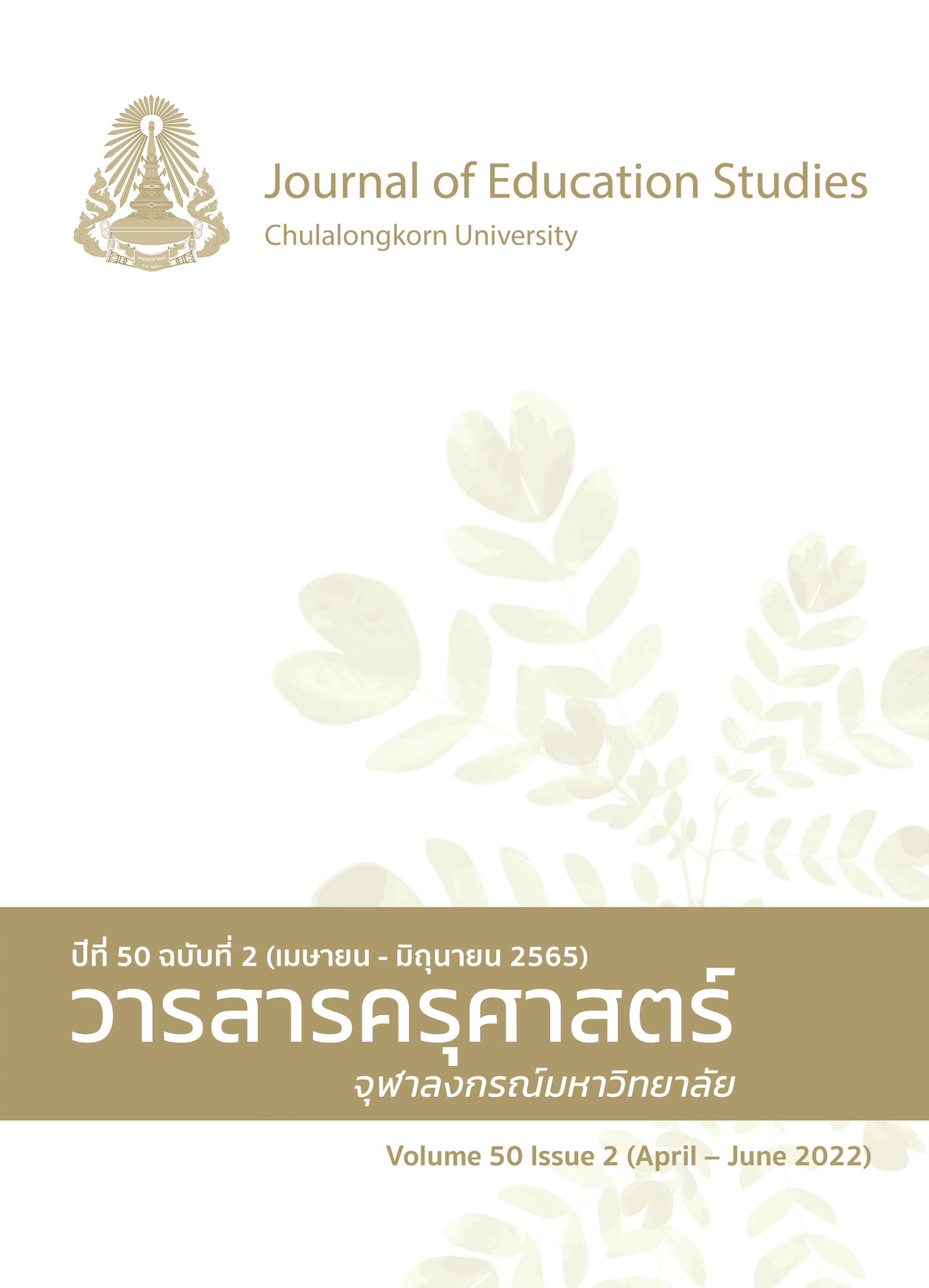The Development of Thai Grammatical Concept and Learning Engagement of Matthayomsuksa 1 Students by Using Gamification with Peer Teaching Techniques
DOI:
https://doi.org/10.14456/educu.2022.13Keywords:
Thai grammatical concept, learning engagement, gamification, peer teaching techniquesAbstract
The purposes of this research were to: 1) compare students’ understanding of Thai grammatical concepts before and after the implementation of gamification and peer techniques, and 2) compare the students’ learning engagement before and after using gamification and peer teaching techniques. The sample of this research was comprised of 30 Matthayomsuksa 1. The research instruments were a Thai grammatical concept test and a student learning engagement questionnaire. The statistical analyses employed in this study were mean (M), standard deviation (SD), and dependent sample t-test. The results of this research were as follows: 1) The understanding of Thai grammatical concepts of Matthayomsuksa 1students was higher after the implementation of gamification and peer teaching techniques at the .05 level of significance, and 2) The Matthayomsuksa 1 students’ level of learning engagement was also higher after gamification and peer teaching techniques were used at the .05 level of significance.
References
ภาษาไทย
กระทรวงศึกษาธิการ. (2553). หลักสูตรแกนกลางการศึกษาขั้นพื้นฐาน พุทธศักราช 2551 (พิมพ์ครั้งที่ 3). โรงพิมพ์ชุมนุม
สหกรณ์การเกษตรแห่งประเทศไทย
กฤษณพงศ์ เลิศบำรุงชัย. (2562, 19 กุมภาพันธ์). การจัดการเรียนรู้เชิงรุก (active learning) ด้วยเกมมิฟิเคชัน
(Gamificaition). Touch Point. https://touchpoint.in.th/active-learning-gamification
กำชัย ทองหล่อ. (2533). หลักภาษาไทย. สำนักพิมพ์บำรุงสาส์น.
กุหลาบ มัลลิกะมาส. (2551). การสัมมนาระดับชาติเนื่องในวันภาษาไทยแห่งชาติ : การแก้วิกฤตภาษาไทย 26 กรกฎาคม
ณ ห้องประชุมสันติไมตรี ทำเนียบรัฐบาล. สมาคมครูภาษาไทยแห่งประเทศไทย.
กาญจนา นาคสกุล. (2551). การสัมมนาระดับชาติเนื่องในวันภาษาไทยแห่งชาติ : การแก้วิกฤตภาษาไทย 26 กรกฎาคม
ณ ห้องประชุมสันติไมตรี ทำเนียบรัฐบาล. สมาคมครูภาษาไทยแห่งประเทศไทย.
ชัยวัฒน์ สุทธิรัตน์. (2561). 80 นวัตกรรมการจัดการเรียนรู้ที่เน้นนักเรียนเป็นสำคัญ (พิมพ์ครั้งที่ 8). พี บาลานซ์ดีไซด์
แอนด์ปริ้นติ้ง.
ฐะปะนีย์ นาคทรรพ. (2541). การสอนหลักภาษาไทยอย่างไรไม่น่าเบื่อ. วารสารวิชาการ, 1(9), 14-19.
นครินทร์ สุกใส. (2561). ผลการจัดการเรียนรู้โดยใช้ห้องเรียนกลับด้านร่วมกับเกมมิฟิเคชันที่มีต่อความสามารถใน
การประยุกต์ความรู้ทางคอมพิวเตอร์ของนักเรียนมัธยมศึกษาตอนปลาย. [วิทยานิพนธ์ปริญญามหาบัณฑิต,
จุฬาลงกรณ์มหาวิทยาลัย] Chulalongkorn University Intellectual Repository (CUIR).
https://cuir.car.chula.ac.th/bitstream/123456789/61392/1/5883897427.pdf
นันทวัน วัฒนมงคลสุข, วรพงษ์ คุณเดชอมร และศิรินาถ บูรณพงศ์. (2560). เทคนิคการสอนไวยากรณ์ภาษาอังกฤษแบบเพื่อน
ช่วยเพื่อน. วารสารนครราชสีมา, 11(3), 277-278.
เบญจภัค จงหมื่นไวย์, กริช กองศรีมา, แสงเพ็ชร พระฉาย, สายสุนีย์ จับโจร และอรัญ ซุยกระเดื่อง. (2561). เกมมิฟิเคชันเพื่อการเรียนรู้ (Gamification for Learning). วารสารการประยุกต์ใช้เทคโนโลยีสารสนเทศ, 4(2), 34-43.
ราชบัณฑิตยสภา. (2557, 21 มีนาคม). มโนทัศน์. สำนักงานราชบัณฑิตยสภา. http://legacy.orst.go.th/?Knowledges
วันชัย แก้วหนูนวล และ ภัสร์ธีรา ฉลองเดช. (2561). ลักษณะข้อผิดพลาดในการใช้ภาษาไทย : กรณีศึกษาด้านการใช้ภาษาไทยของนักศึกษาปริญญาตรีชั้นปีที่ 1 มหาวิทยาลัยนราธิวาสราชนครินทร์. วารสารนราธิวาสราชนครินทร์ สาขามนุษยศาสตร์และสังคมศาสตร์, 5(2), 1-11.
ศุภกร ถิรมงคลจิต. (2558). ผลของการจัดกิจกรรมการเรียนรู้วิชาวิทยาศาสตร์ตามแนวคิดเกมิฟิเคชัน เพื่อเสริมสร้างแรงจูงใจ
ในการเรียนของนักเรียนชั้นประถมศึกษาปีที่ 2. [วิทยานิพนธ์ปริญญามหาบัณฑิต, จุฬาลงกรณ์มหาวิทยาลัย].
Chulalongkorn University Intellectual Repository (CUIR). https://cuir.car.chula.ac.th/handle/
/51063?fbclid
สำนักทดสอบทางการศึกษา. (2563, 26 มีนาคม). สรุปผลการทดสอบทางการศึกษาระดับชาติขั้นพื้นฐาน ระดับชั้น มัธยมศึกษาปีที่ 3 ปีการศึกษา 2562. สทศ. http://www.newonetresult.niets.or.th/AnnouncementWeb
สุอัมพร ปานทรัพย์. (2559). การประยุกต์ใช้องค์ประกอบของเกมในกิจกรรม CSR : กรณีศึกษาธนาคารขยะ. วารสาร
ปัญญาภิวัตน์, 9(2), 197-207.
อติกันต์ ภูดีทิพย์. (2552). การศึกษาผลสัมฤทธิ์ทางการเรียนวิทยาศาสตร์และพฤติกรรมด้านคุณธรรม จริยธรรมพื้นฐาน 8
ประการ ของนักเรียนชั้นมัธยมศึกษาปีที่ 3 โดยใช้การจัดการเรียนรู้แบบกลุ่มเพื่อนช่วยเพื่อน. [สารนิพนธ์ปริญญา
มหาบัณฑิต, มหาวิทยาลัยศรีนครินทรวิโรฒ]. Integrated Thesis & Research Management System. http://thesis.swu.ac.th/swuthesis/Sec_Ed/Atikan_P.pdf
อรุณี ราชพัฒน์, ภัทราพร เกษสังข์, และพิกุล ภูมิโคกรักษ์. (2555). ปัจจัยที่มีอิทธิพลต่อผลสัมฤทธิ์ทางการเรียนวิชาภาษาไทยของนักเรียนสังกัดสำนักงานการศึกษาขั้นพื้นฐาน : การวิเคราะห์พหุระดับ. วารสารวิจัยและพัฒนามหาวิทยาลัยราชภัฏเลย, 7(22), 1-12.
ภาษาอังกฤษ
Al-Azawi, R., Al-Faliti, F., & Al-Blushi, M. (2016). Educational gamification vs. game based learning: Comparative study. International Journal of
Innovation, Management and Technology, 7(4), 132-136. http://doi.org/10.18178/ijimt.2016.7.4.659
Ali, N., Anwer, M., & Jaffar, A. (2015). Impact of peer tutoring on learning of student. Journal for Studies in
Management and Planning, 1(2), 213-225. http://internationaljournalofresearch.org/index.php/
JSMaP
Chevtchenko, A. (2013). Gamified education: Introducing game elements into the school environment
to enhance student motivation and performance. [Unpublished doctoral dissertation]. Erasmus University Rotterdam.
Finn, J. D., & Zimmer, K. S. (2012). Student engagement: What is it? Why does it matter? In S. L.
Christenson, A. L. Reschly, & C. Wylie (Eds.), Handbook of research on student engagement,
–131. https://doi.org/10.1007/978-1-4614-2018-7_5
Gafni, R., Achituv, D. B., Eidelman, S., & Chatsky, T. (2018). The effects of gamification elements in
e-learning platforms. Online Journal of Applied Knowledge Management (OJAKM), 6(2), 37-53. https://doi.org/10.36965/OJAKM.2018.6(2)37-53
Kapp, K. M. (2012). The gamification of learning and instruction: game – based methods and strategie for
training and education. John Wiley and Sons.
Koenig, J. M. (2016). Gamification and the creation of academic writer’s identity. [Master’s Thesis,
Colorado State University]. Mountain Scholar. https://mountainscholar.org/handle/10217/172967
Lee, J. J., & Hammer, J. (2011). Gamification in education: What, how, why bother? Academic Exchange
Quarterly, 15(3), 146. https://www.researchgate.net/publication/258697764
Machajewski, S. (2017). Gamification strategies in a hybrid exemplary college course. International Journal
of Educational Technology, 4(3), 1-16. https://educationaltechnology.net/ijet/index.php/ijet
Muntean, C. I. (2011). Raising engagement in e-learning through gamification. Proc. 6th International
Conference on Virtual Learning ICVL, 5(2), 323-329.
Nah, F. F. H., Zeng, Q., Telaprolu, V. R., Ayyappa, A. P., & Eschenbrenner, B. (2014). Gamification of
education: a review of literature. In International conference on hci in business, 5(2), 401-409.
https://link.springer.com/chapter/10.1007/978-3-319-07293-7_39
National Survey of Student Engagement. (2007). Experiences that matter: Enhancing student learning and
success. Center for Postsecondary Research. http://nnse.indiana.edu/nsse/reports-
data/index.html
Neal, A. W. (1988). Peer teaching: To teach is to learn twice. Ashe – Eric Higher Education Report, 3(4),
-266. https://eric.ed.gov/?id=ED305016
Saran, M., Al-Magsoosi, D., & Mohammed, D. (2018). Gamification in e-learning: The effect on student
performance. 9th Annual International Conference on Computer Science Education: Innovation
and Technology, 3-4. http://www.researchgate.net/publication/329415817
Stigmar, M. (2016). Peer-to-peer teaching in higher education: A critical literature review. Mentoring and
Tutoring Partnership in Learning, 24(2), 124-136. https://doi.org/10.1080/13611267.2016.1178963
Trowler, V. (2010). Student engagement literature review. The Higher Education Academy, 11(1), 1-15.
http://www.researchgate.net/publication/322342119
Velez J. J., Cano, J., Whittingtion, M. S., & Wolf, K. J. (2011). Cultivating change through peer teaching.
Journal of Agricultural Education, 52(4), 40-49. http://eric.ed.gov/?id=EJ955665
Downloads
Published
How to Cite
Issue
Section
License

This work is licensed under a Creative Commons Attribution-NonCommercial-NoDerivatives 4.0 International License.




